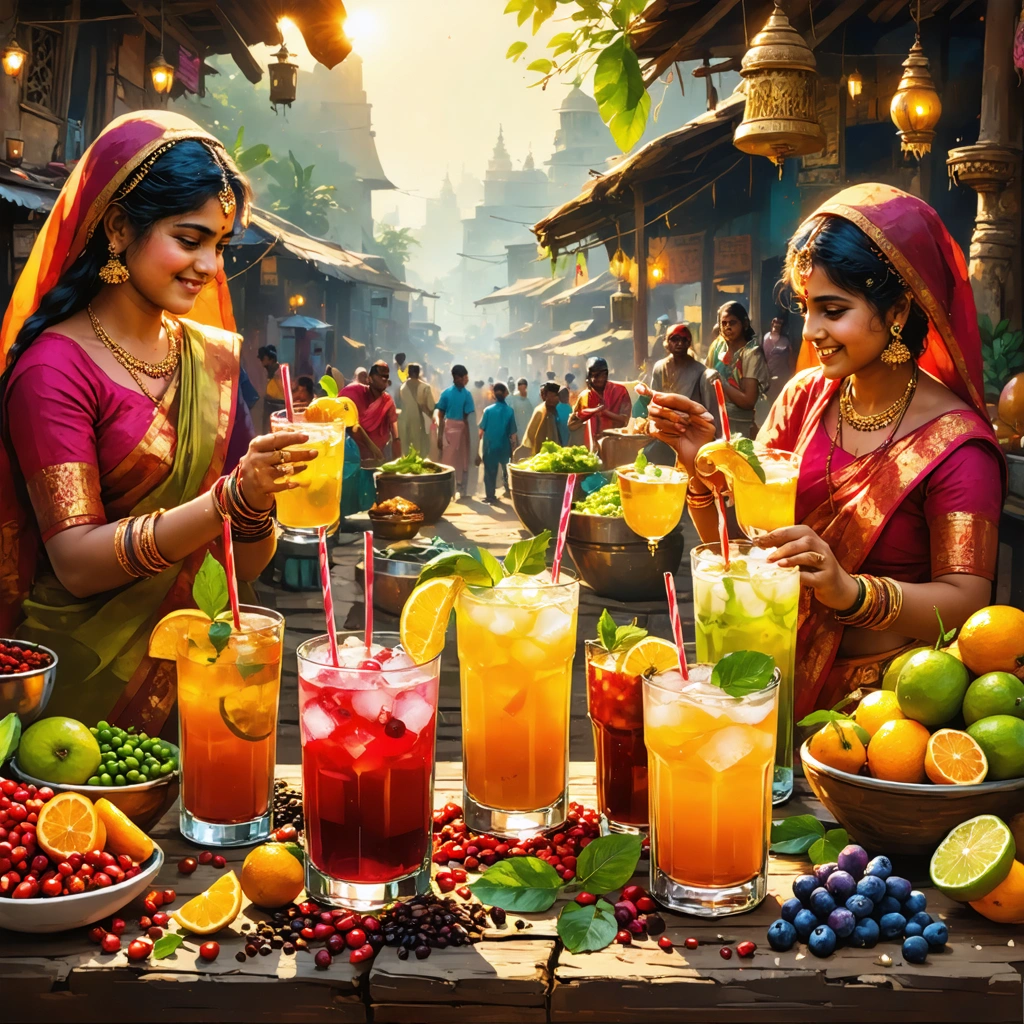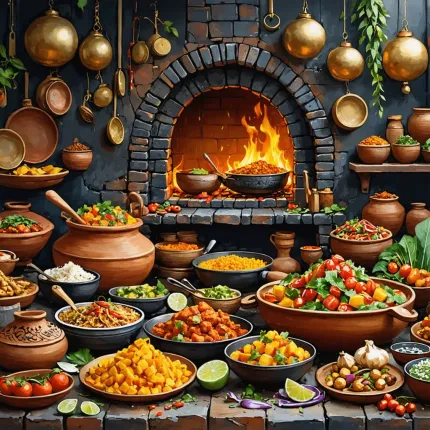
Discovering the Hidden Flavors Beyond the Usual Cup
Imagine walking through a bustling Indian village, the air thick with the scent of spices and fresh earth. You’re offered a drink that’s unlike anything you’ve tasted before—perhaps something derived from the sap of the Tadi Ka Ped, or infused with the rich essence of Jaitun Ka Tel. These are not just exotic names; they are gateways to centuries-old traditions, local cultures, and stories steeped in heritage. Yet, despite the vast tapestry of India’s culinary landscape, many of these regional beverages remain unsung heroes in the global arena of drinks.
It’s easy to get overwhelmed by the ubiquity of chai and lassi when thinking about Indian beverages. But what about the lesser-known treasures like the energizing brews from the Tadi Ka Ped or the subtle, aromatic notes introduced by Tilli Ka Tel in certain recipes? These unique ingredients have been quietly shaping the palate of their native regions for generations, but their charm often remains hidden from mainstream appreciation.
Why does this happen? One reason is the sheer diversity and complexity across India’s regions. Each state, often each village, boasts its own signature drinks crafted from local flora, agricultural bounty, and age-old techniques. The challenge lies in how to navigate this vast landscape without feeling lost or overwhelmed. Many travelers and even locals find themselves stuck in a repetitive cycle of familiar beverages, missing out on the vibrant spectrum of tastes available just around the corner.
From Tradition to Trend: Embracing India’s Beverage Heritage in 2025
But here’s the exciting part: 2025 is shaping up to be a turning point for the resurgence of these regional gems. As people across India and beyond become more adventurous and health-conscious, there is a growing curiosity about foods and drinks that offer not only flavor but also nourishment. Ingredients like Jaitun Ka Tel—an oil extracted from olives grown in select Indian regions—are gaining attention not just for cooking but for their subtle influence on beverages that promise wellness alongside refreshment.
Similarly, Tadi Ka Ped—the iconic palm tree whose sap can be fermented into toddy or enjoyed fresh—represents a connection to nature and tradition that modern consumers crave. This drink carries with it stories of rural life, communal gatherings, and a slower pace of living that many urban dwellers find soothing and nostalgic. Incorporating such regional beverages into everyday life could mean more than just quenching thirst; it’s about embracing a lifestyle that honors the past while looking toward the future.
And let’s not overlook Tilli Ka Tel, or sesame oil, which has long been a staple in Indian kitchens and Ayurvedic practices. Beyond its culinary uses, it enriches certain drinks with its nutty undertones and health benefits, making it a fascinating element in the evolving narrative of Indian beverages. As people seek authentic, nutrient-packed options, these regional specialties offer a refreshing alternative to mass-produced drinks.
What to Expect in This Exploration
This article will take you on a flavorful journey through India’s regions, highlighting the unique beverages that define them. You’ll learn how local ingredients like Tadi Ka Ped, Jaitun Ka Tel, and Tilli Ka Tel shape these drinks, and why they deserve a place on your palate in 2025 and beyond. From traditional recipes passed down through generations to innovative modern twists, we’ll uncover the stories, flavors, and cultural significance behind these beverages.
Whether you’re a traveler eager to taste authentic local drinks, a food enthusiast curious about India’s culinary diversity, or someone searching for healthier and more meaningful beverage options, this guide will open new doors. Prepare to savor the richness of India’s regions, one sip at a time.

Regional Beverages of India: Savor the Unique Beverages of India’s Regions in 2025
What are some iconic regional beverages of India in 2025?
India’s vast cultural diversity translates into an equally diverse array of traditional beverages, each with unique flavors, ingredients, and cultural significance. In 2025, these beverages continue to hold an important place in everyday life as well as festivals, rituals, and social gatherings.
From the cool and refreshing sol kadhi of Maharashtra to the sweet and spicy lassi of Punjab, regional drinks are cherished for their ability to reflect local tastes and climates. Many of these beverages are also linked to indigenous ingredients like Tadi Ka Ped, a tree whose sap is fermented to produce a mildly alcoholic drink in parts of central India, showcasing the use of natural resources in traditional brewing.
How does Tadi Ka Ped influence traditional regional beverages?
Tadi Ka Ped refers to the palm tree species whose sap is tapped to produce toddy, a popular fermented drink in regions like Kerala, Goa, and parts of central India. The toddy extracted from the Tadi Ka Ped is naturally sweet and undergoes a short fermentation period, resulting in a mildly alcoholic, refreshing beverage.
This traditional practice serves both cultural and economic roles, as toddy tapping is a livelihood for many rural communities. The beverage is particularly favored in warm climates due to its cooling properties and is often consumed fresh or used as a base for local cocktails and culinary recipes.
Understanding Tadi Ka Ped and toddy production offers insight into how regional beverages are deeply intertwined with the environment, economy, and culture of specific Indian regions.
What role do oils like Jaitun Ka Tel and Tilli Ka Tel play in Indian regional beverage traditions?
While Jaitun Ka Tel (olive oil) and Tilli Ka Tel (sesame oil) are primarily known for culinary uses, they also influence beverage culture, especially in Ayurvedic and health-focused drinks.
Jaitun Ka Tel is gaining popularity in India for its health benefits and is occasionally used as an ingredient in herbal tonic preparations and health drinks. Its antioxidant properties make it a sought-after addition to traditional beverage blends aimed at boosting immunity and vitality.
Tilli Ka Tel, on the other hand, has a long history in Indian wellness drinks. It is often used in small quantities in warm milk or herbal concoctions to enhance flavor and provide health benefits such as improved digestion and skin health.
Both oils illustrate how traditional beverages are evolving by incorporating time-tested natural ingredients that align with modern health trends, enriching the sensory and therapeutic qualities of regional drinks.
Which regions of India are known for their unique beverages, and what makes them special in 2025?
Every Indian region offers distinctive beverages shaped by local ingredients, climate, and cultural practices. Here are some notable examples in 2025:
- South India: Drinks like Neer Mor (spiced buttermilk) and toddy from Tadi Ka Ped are staples, valued for hydration and cooling effects in hot climates.
- North India: The robust lassi and herbal teas infused with local spices remain popular, often enhanced with sesame oil (Tilli Ka Tel) in Ayurvedic formulations.
- West India: Maharashtra’s Sol Kadhi, made from kokum and coconut milk, is a refreshing digestive aid, frequently paired with toddy-based beverages.
- East India: The tea culture of Assam and West Bengal thrives, alongside unique fermented rice beverages.
- Central India: The use of Tadi Ka Ped for toddy and inclusion of local oils like Jaitun Ka Tel in health tonics showcases a blend of tradition and innovation.
These regional beverages are more than just drinks; they are living traditions that embody the history, ecology, and evolving tastes of their communities.
How are modern trends shaping the future of India’s regional beverages?
In 2025, there is a growing movement to preserve and promote indigenous beverages while adapting them to contemporary tastes and health consciousness. This includes:
- Commercialization of traditional drinks like toddy from Tadi Ka Ped with improved hygiene and packaging.
- Incorporation of healthful oils such as Jaitun Ka Tel and Tilli Ka Tel in wellness beverages and functional drinks aimed at urban consumers.
- Use of digital platforms for storytelling and marketing, helping to educate consumers about the origins and benefits of these drinks.
- Innovative blends combining traditional ingredients with modern flavors to appeal to younger generations while preserving authenticity.
Such trends ensure that regional beverages remain relevant and accessible, contributing to sustainable livelihoods and cultural heritage preservation.
What should one know before trying traditional Indian regional beverages?
When exploring India’s regional beverages, it’s important to understand their cultural context, preparation methods, and potential health effects:
- Many beverages are seasonally available and tied to local festivities or agricultural cycles.
- Freshness is key, especially for fermented drinks like toddy from Tadi Ka Ped, which can ferment rapidly and change flavor profile within hours.
- Understanding ingredient origins, such as the use of Jaitun Ka Tel or Tilli Ka Tel, adds appreciation for their health benefits and culinary role.
- Be mindful of alcohol content in fermented regional drinks, and consume responsibly.
By approaching these beverages with respect and curiosity, one can truly savor the rich tapestry of India’s regional drink heritage.


